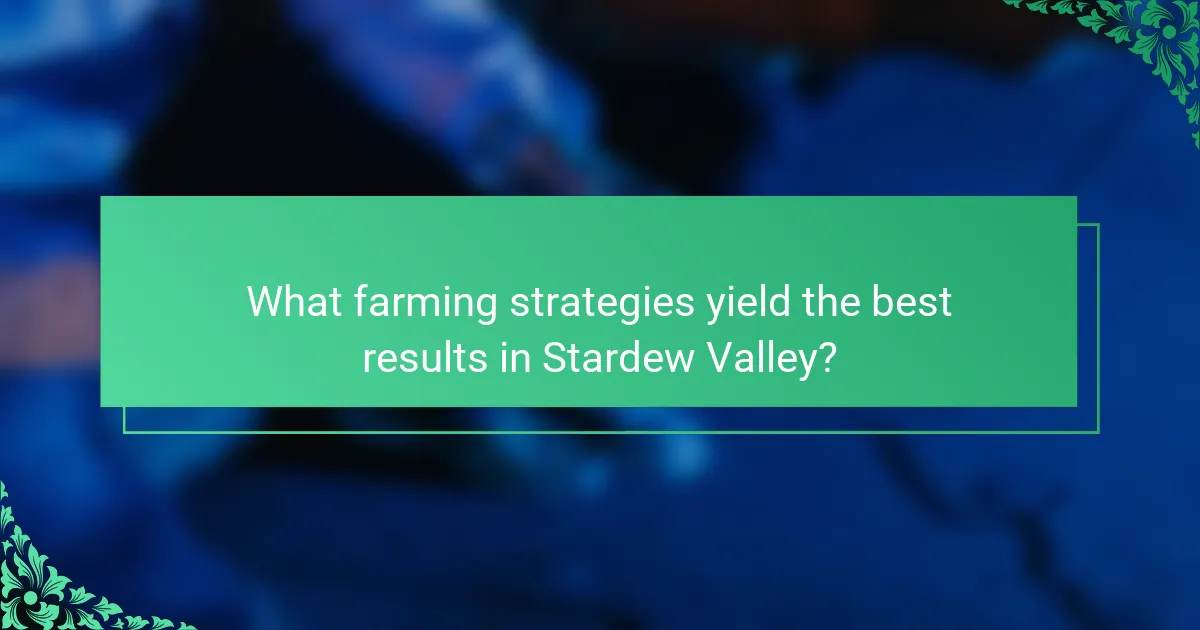Stardew Valley offers players a rewarding experience through its engaging game mechanics and diverse activities. Explore effective farming strategies, including crop rotation and seasonal planning, to maximize yields. Discover the importance of community engagement and how it enhances gameplay through collaboration and social interaction. Learn to navigate challenges like resource management and time constraints for a more fulfilling farming journey.

How do game mechanics influence player engagement in Stardew Valley?
Game mechanics in Stardew Valley significantly enhance player engagement by providing diverse activities and rewarding progression. The combination of farming, crafting, and relationship-building fosters a sense of achievement. Players experience unique attributes, such as seasonal events and festivals, which create a dynamic environment. These mechanics encourage exploration and experimentation, resulting in a rich, immersive experience that keeps players returning. Additionally, the game’s open-ended nature allows for personalized strategies, enhancing the overall enjoyment and replayability.
What are the core gameplay elements that define Stardew Valley?
Stardew Valley’s core gameplay elements include farming, resource management, and community interaction. Players cultivate crops, raise animals, and explore various environments. Farming strategies involve crop rotation and seasonal planning. Community engagement is enhanced through relationships and festivals, promoting social dynamics. Unique attributes like crafting and mining add depth to gameplay, offering diverse experiences.
How does the farming system work in Stardew Valley?
In Stardew Valley, the farming system revolves around planting crops, raising animals, and managing resources. Players can cultivate a variety of crops through seasons, each with unique growth times and benefits. Crop quality improves with care and fertilizer, enhancing market value. Additionally, players can raise animals for products like eggs and milk, contributing to farm income. The farming system encourages strategic planning and resource management to optimize productivity and community engagement.
Which crafting and resource management strategies enhance gameplay?
Crafting and resource management strategies in Stardew Valley enhance gameplay by maximizing efficiency and productivity. Prioritize crop selection based on seasons and profitability. Utilize crafting stations to create valuable items, like potions and artisan goods, which can be sold for profit. Engage in community projects to strengthen relationships and unlock rewards. Optimize your farm layout to streamline tasks, ensuring easy access to resources and crops. Implementing these strategies leads to a more rewarding and successful farming experience.
How do seasonal changes affect game mechanics and player strategies?
Seasonal changes significantly impact game mechanics and player strategies in Stardew Valley. Each season introduces unique crops, events, and challenges that require players to adapt their farming techniques and community engagement.
For example, spring allows players to plant crops like strawberries, while summer features crops such as blueberries. Players must plan their planting schedules to maximize yield. Seasonal festivals, like the Egg Festival in spring, also encourage community interaction, influencing player strategies to build relationships.
Additionally, seasonal changes affect resource availability. For instance, winter restricts farming, prompting players to focus on foraging and fishing. This shift in gameplay encourages strategic diversification of activities, enhancing overall engagement with the game.

What farming strategies yield the best results in Stardew Valley?
Crop rotation, efficient use of fertilizers, and seasonal planning yield the best results in Stardew Valley. Implementing these strategies maximizes crop yield and profitability.
Crop rotation involves alternating different types of crops to maintain soil health and prevent depletion of nutrients. For example, planting wheat followed by legumes can enhance soil fertility.
Efficient use of fertilizers boosts crop growth rates and increases yield. Utilizing quality fertilizers, such as Speed-Gro, can significantly shorten crop growth time, allowing for more harvests within a season.
Seasonal planning ensures that players plant crops suited to the specific season. For instance, strawberries thrive in spring, while pumpkins flourish in autumn, maximizing the potential for profit.
How do crop selection and rotation impact farm productivity?
Crop selection and rotation significantly enhance farm productivity by optimizing soil health and crop yield. Choosing the right crops can improve nutrient availability and reduce pest pressures. Crop rotation prevents soil depletion, enhances biodiversity, and disrupts pest and disease cycles. For example, alternating between legumes and cereals can replenish nitrogen levels in the soil. This strategic approach leads to sustainable farming practices and increased overall output.
What are the benefits of animal husbandry versus crop farming?
Animal husbandry offers benefits like consistent product supply and diversified income compared to crop farming. Animal products, such as milk and eggs, provide ongoing revenue, while crops depend on seasonal yields. Additionally, livestock can enhance soil fertility through manure, improving crop yields in the long term. However, animal husbandry requires more management and care than crop farming, which can be a simpler, less resource-intensive option for some farmers.
How can players optimize their farm layout for efficiency?
Players can optimize their farm layout by strategically placing crops, buildings, and pathways to enhance efficiency. Grouping similar crops together maximizes space and simplifies harvesting. Utilize sprinklers to automate watering, reducing time spent on daily tasks. Maintain clear pathways for easy movement and access to all areas. Consider the placement of farm buildings to minimize obstruction and ensure smooth workflow. Additionally, plan for seasonal crop rotation to maximize yield throughout the year.
Which advanced farming techniques can maximize profits?
Advanced farming techniques in Stardew Valley include crop rotation, greenhouse utilization, and artisan goods production. These strategies can significantly enhance profit margins by optimizing resource use and maximizing crop yield.
Crop rotation involves alternating different crops to improve soil quality and increase overall harvests. Utilizing the greenhouse allows year-round crop growth, bypassing seasonal restrictions. Focusing on artisan goods, such as wine or cheese, can yield higher profits than selling raw crops directly.
Additionally, investing in high-quality seeds and using fertilizer further boosts crop performance. Engaging with community events can provide unique rewards that enhance farming efficiency.

How does community engagement enhance the Stardew Valley experience?
Community engagement significantly enhances the Stardew Valley experience by fostering collaboration and social interaction among players. Engaging with the community allows players to share farming strategies, trade items, and participate in seasonal events, enriching gameplay. This interaction cultivates a sense of belonging and encourages creativity, as players can showcase their farms and achievements. Moreover, community-driven content, such as mods and fan art, further expands the game’s universe, providing unique experiences that keep players invested.
What role do festivals and events play in community building?
Festivals and events foster community building by creating shared experiences and strengthening social bonds. In Stardew Valley, seasonal festivals enhance player engagement, promote cooperation, and deepen relationships among villagers. These gatherings encourage participation in activities that reflect community values, such as harvest celebrations and competitions. Players experience a sense of belonging and connection, which enhances the overall enjoyment of the game and encourages continued interaction with the community.
How can players build relationships with villagers effectively?
Players can build relationships with villagers effectively by consistently interacting and fulfilling their needs. Engage daily by talking, giving gifts, and completing quests.
Gifting items that villagers love boosts friendship levels significantly. Pay attention to their preferences, which can be found in the in-game menu. Completing seasonal events and festivals enhances community bonds and allows for unique interactions.
Participating in cooperative activities, like farming or fishing together, fosters camaraderie. Building a strong relationship with villagers unlocks valuable rewards, including recipes and special events. Engaging with their stories and responding positively to their dialogues deepens connections.
What are the benefits of participating in community projects?
Participating in community projects enhances social connections, fosters teamwork, and improves problem-solving skills. Engaging with others in Stardew Valley allows players to share resources, strategies, and experiences, enriching the gaming experience. This collaboration can lead to a more vibrant in-game community, as players work together to achieve common goals. Additionally, community projects often provide unique rewards and experiences that deepen player engagement and satisfaction.

What unique features set Stardew Valley apart from other farming games?
Stardew Valley stands out due to its intricate blend of farming mechanics, social interactions, and personalization. Unique features include a diverse range of crops, animals, and crafting options that allow players to customize their farms. The game’s community engagement is enhanced through festivals, relationships with villagers, and cooperative multiplayer mode. Additionally, the open-ended gameplay lets players pursue various paths, such as mining or fishing, creating a rich, immersive experience.
How does the game’s narrative depth contribute to its appeal?
The game’s narrative depth significantly enhances its appeal by creating immersive experiences. Players engage with rich storylines, character development, and emotional connections. This depth fosters a sense of belonging and investment in the game’s world. Unique narratives, like personal quests and community events, differentiate Stardew Valley from other farming simulators. As a result, players often return, motivated by their attachment to the characters and unfolding stories.
What innovative multiplayer options are available in Stardew Valley?
Stardew Valley offers innovative multiplayer options, including co-op farming and competitive play. Players can collaborate to build farms, share resources, and engage in seasonal events. The game supports up to four players in a single farm, enhancing community engagement. Unique features like split-screen mode and online co-op allow for diverse gameplay experiences. Additionally, players can visit each other’s farms, fostering a sense of community.
How do modding and user-generated content expand gameplay possibilities?
Modding and user-generated content significantly enhance gameplay possibilities in Stardew Valley by introducing new mechanics and features. These additions allow players to customize their experience, fostering creativity and extending replay value.
Modding enables the creation of unique farming strategies, such as new crop types or advanced automation systems. User-generated content, like custom maps and quests, enriches the game’s narrative and exploration aspects. As a result, the community actively engages in sharing and implementing these modifications, creating a vibrant ecosystem of innovation.
This collaborative environment encourages players to experiment and share their creations, leading to a continually evolving gameplay landscape. The unique attributes of modding, such as the ability to alter core mechanics, set Stardew Valley apart from other titles, making it a beloved choice for fans of sandbox games.

What are the common challenges players face in Stardew Valley?
Players in Stardew Valley commonly face challenges such as resource management, time constraints, and seasonal changes. Resource management involves balancing crops, animals, and crafting materials. Time constraints limit daily activities, requiring efficient planning. Seasonal changes affect crop growth and available resources, adding complexity to farming strategies. Additionally, players may struggle with community engagement, as building relationships requires time and effort.
How can players overcome resource scarcity in early game stages?
Players can overcome resource scarcity in early game stages by prioritizing efficient farming and resource management. Focus on crop selection that yields high profit, such as strawberries or blueberries. Utilize foraging to gather wild resources, which can supplement food and crafting materials. Build relationships with villagers to unlock trade opportunities and receive gifts. Crafting basic tools and structures early on can enhance productivity and reduce reliance on scarce resources. Implementing these strategies will help players thrive despite initial limitations.
What strategies can help manage time effectively in gameplay?
To manage time effectively in Stardew Valley, prioritize tasks and use a daily schedule. Focus on key activities like farming, foraging, and socializing to maximize productivity.
1. Set daily goals based on seasons and crop cycles.
2. Utilize the calendar to plan community events and festivals.
3. Upgrade tools to save time on resource gathering.
4. Use the in-game map to optimize travel routes.
5. Engage with villagers to unlock new quests and rewards.
These strategies enhance gameplay efficiency and community engagement.
How do players deal with unexpected events and disasters?
Players in Stardew Valley adapt to unexpected events and disasters through strategic planning and resource management. They often stockpile supplies, such as food and crafting materials, to mitigate the impact of adverse situations.
For example, when faced with a crop failure due to a storm, players can rely on stored food or forage for wild items. Additionally, building relationships with villagers can provide support, such as receiving gifts or assistance during tough times.
Players also utilize in-game tools, like sprinklers and fences, to protect crops and livestock from disasters. Preparedness and flexibility are key strategies for overcoming challenges in the game.

What expert tips can enhance the Stardew Valley experience?
To enhance the Stardew Valley experience, focus on efficient farming strategies, effective community engagement, and mastering game mechanics. Prioritize crop rotation to maximize yield and diversify your farm. Engage with villagers to unlock new quests and rewards. Utilize seasonal events to gather unique resources and build relationships. Experiment with crafting to create valuable items that boost your farming efficiency.
Which best practices should players follow for successful farming?
Players should follow efficient crop rotation, prioritize high-value crops, utilize tools effectively, and engage with the community. These practices enhance productivity and overall success in farming.
Effective crop rotation involves planting different crops each season to maximize yield and soil health. High-value crops like strawberries and blueberries provide greater returns, making them ideal choices. Utilizing upgraded tools, such as sprinklers, saves time and energy, allowing for more efficient farming. Engaging with the community through festivals and events fosters relationships and offers valuable resources.
What common mistakes should players avoid to improve their gameplay?
Players should avoid common mistakes like neglecting crop rotation, ignoring community centre bundles, and failing to manage energy effectively. These errors can hinder progress and enjoyment in Stardew Valley.
Neglecting crop rotation leads to lower yields and wasted resources. Players should diversify crops each season to maximize profits. Ignoring community centre bundles prevents access to valuable rewards that enhance gameplay. Completing these bundles should be a priority.
Failing to manage energy effectively results in reduced productivity. Players should plan their activities and use food strategically to maintain energy levels. Prioritizing these aspects can significantly improve gameplay experience.
How can players balance community engagement with farming efficiency?
Players can balance community engagement with farming efficiency by prioritizing time management and strategic interactions. Focusing on tasks that yield both crop benefits and social relationships enhances overall gameplay. For instance, participating in community events boosts friendships while allowing time for farming activities.
Additionally, players should utilize the game’s calendar to plan their farming schedule around community events. This ensures that essential crops are harvested while still engaging with villagers. Efficient use of in-game time maximizes both farming output and social connections, creating a rewarding experience.
Engaging in gift-giving can also strengthen relationships without significantly detracting from farming tasks. Selecting gifts that align with villagers’ preferences improves friendship levels and can lead to valuable rewards.
Ultimately, the key lies in integrating community activities into the farming routine, allowing players to thrive in both aspects of Stardew Valley.


